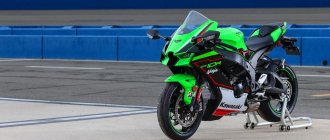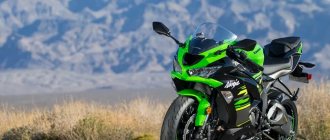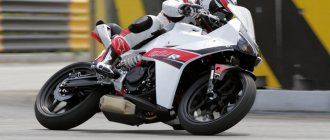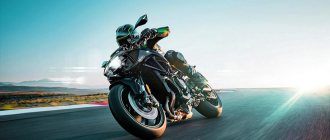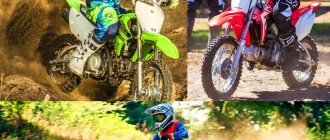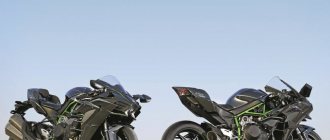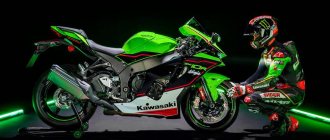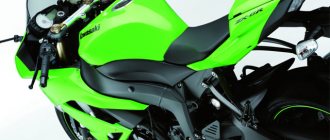Among the legendary Kawasaki models, the ZX-6R occupies one of the leading positions. In the course of evolution, engineers managed to create one of the best mid-sized sportbikes in history. Despite all the efforts of competitors, with each new generation “Ninja” becomes the most evil sports “six hundred”. Thousands of athletes around the world have appreciated the progressive engineering solutions, reliability and unpretentiousness. Different generations of this motorcycle are loved in their own way by both motorcycle racers and stunt riders.
First generation (1995–1997)
In 1995, the Kawasaki ZZ - R 600 (the model remained in production, but was reoriented as a sports tourer) was replaced by a completely new 600 cm3 sports bike, the Kawasaki ZX -6 R Ninja. The motorcycle at that time had a competitive 105 hp engine. s., progressive suspensions and good braking mechanisms, but its main advantage is the aluminum frame, the presence of which none of the competing motorcycles in the same class could boast of.
The engine design is proven and reliable, which cannot be said about the gearbox; quite often there are problems with the second gear slipping out (which, by and large, can be considered the result of a long mileage and careless use). Problems with fuel pump failure are common.
On motorcycles in 1995, the frame cracked even with the slightest drop (the manufacturer managed to replace most of the frames under warranty); in 1996, the structure was strengthened.
Externally, the “six hundred” looks almost the same as the older model ZX -9 R. The plastic tail is durable, but has a catch - due to the design features, installation of the sliders is complicated.
Finding a fully technically functional first-generation motorcycle on the secondary market (especially one that has traveled around Russia) is a great success. To a certain extent, it is pointless to talk about any special narrow malfunctions; the condition of each specific surviving specimen is made up of a bunch of breakdowns acquired over many thousands of kilometers. Consumables are freely available, but the same cannot be said about spare parts.
Second generation (1998–1999)
Two years after the start of production, the motorcycle received a number of cosmetic changes. The exhaust pipe changed color from black to silver, and the driver's seat received an increase in length. The rear subframe is no longer integral with the frame, but is a removable part. The plastic cladding is all new with slightly smoother curves. The engine and gearbox remain the same, a slight increase in power is the result of painstaking adjustments to the intake and exhaust systems. It is impossible not to note the appearance of six-piston front calipers as standard (previously four-piston ones were installed).
According to modern ideas, the Kawasaki ZX -6 R of the first and second generations have long been out of the sports status, now completely different power and weight indicators are at stake. The prevalence of such motorcycles on the secondary market is small. The owner will inevitably have problems finding spare parts. The search for a living device is complicated by its venerable age.
Third generation (2000–2002)
By 2000, the Kawasaki ZX-6R model (the same modification under the name ZZR600 was produced from 2005 to 2008) was modernized. The first thing that catches your eye is the complete restyling of the front part of the motorcycle. Instead of one solid headlight, there were two, and the air intake underneath them became more pronounced. Power was added to the carburetor engine, and the motorcycle itself became a little more driver-friendly due to a retuned suspension and a new pendulum. Inherited from the ZX -9 R was an electrochemical coating of the cylinder mirrors, which made it possible to abandon liners. Unfortunately, the work to reduce weight did not pass without a trace; Kawasaki has officially recognized problems with the frame; even a small fall causes its geometry to be disrupted until cracks occur.
The third generation Kawasaki ZX-6R takes an active part in the sport and becomes one of the favorites of the circuit racers of its time. In 2001, Andrew Pitt won the Superbike championship in the 600 cm3 class on a similar motorcycle. Towards the end of the production of the generation, engineers decided to test a new idea and released a transitional model ZX-6R, which differed from the previous one by increasing engine capacity to 636 cm3.
The demand for third generation motorcycles still remains, mainly due to the sufficient number of spare parts and ease of maintenance.
Engine Kawasaki ZX 6R
The protagonist of today's play is Kawasaki's compact 636cc four-cylinder engine. cm , definitely short-stroke, with a piston diameter of 67 mm and a stroke of 45.1 mm. The pistons have shortened skirts to reduce moving masses and increase available rpm. The compression ratio is high - 12.9:1.
A quartet of 38mm Keihin throttle bodies provide this monster with air. The engine has a number of electronic features including power modes and traction control. Power modes allow you to select engine power - full, or 80% of full with a softer response to the throttle, and a three-stage traction control system intervenes in the timing and ignition when it detects wheel slip. In other words, the set of road functions here is excellent, but for the track there is not enough launch control and quickshifter, at least in the stock version.
The clutch of the Kawasaki ZX 6R is slippery and has a lightweight release , so it is not only easy to press, but also allows you not to tear off the wheel with the braking torque during a sharp downshift. The cassette transmission brings the motorcycle closer to modern racing supersports, as does the competent weight distribution: the center of mass of the motorcycle is low and as central as possible.
How does he drive? The manufacturer claims 70.6 Nm at 11,500 rpm, so there is a lot to squeeze out here, but you need to spin it properly first.
Fourth generation (2003–2004)
In 2003, under pressure from the Honda CBR600F4i, Suzuki GSX-R600 and Yamaha YZF-R6, Kawasaki decided to make a move and release a completely redesigned ZX-6 R sportbike. The key strategy that allowed it to beat its competitors was to increase the engine capacity to 636 cm3 (for fans of circuit racing, a limited edition series of motorcycles with an engine capacity of 600 cm3 called ZX-6RR was released). Instead of a difficult-to-maintain carburetor battery, the power system now features an injector. Other changes include a new swingarm, an inverted fork, a retuned gearbox, and new radial four-piston calipers. As a result of all the innovations, the motorcycle’s power increased by 7 hp. s., and dry weight decreased by almost 10 kg.
The appearance has changed quite significantly - there is less plastic, its lines are sharper and clearer, the air intake is now located above the headlights, which have changed significantly, the tail section along with the muffler looks up, hinting at exclusively sporting use.
Due to the pilot's seating position, which is more oriented towards racing use and, accordingly, a rather rigid chassis, the motorcycle is least suitable for utilitarian use. Additional cubic centimeters mean increased power and torque; in this particular case, the Ninja received a significant increase in low-end traction. Such qualities, together with the progressiveness of the chassis, sharply increased interest in the model among stunt riding enthusiasts. During active training, certain weak points emerge: the front fork on the 03–04 model is not very successful, over time the threaded connection of the fork leg with the silumin mount of the caliper and the wheel axle becomes loose, there are cases of a break of the fork in this place (it can be treated by replacing the fork assembly with a similar one from more recent generations); in the event of a slight frontal impact (even the fork may remain level), the frame is crushed in the area of the steering column, this will no longer be possible to correct and replacement will be required; Over time, the ears of the engine mounts and steering column begin to tear off, because of this, some stunt riders switch to new frames made of steel pipes, made specifically for performances and training. The engine is extremely reliable, but requires careful maintenance; occasionally there are motorcycles with the second gear falling out. The valve cover gasket often leaks, many try to solve the problem by tightening the bolts, thereby stretching the mounting points on the upper bed of the camshafts, sometimes they even break off. The problem is solved by replacing the gasket together with the rubber rings under the cover bolts, which become oak with time and heat and do not press the cover. In general, when used correctly, the motorcycle is extremely successful, and there is still no full-fledged replacement for it.
When inspecting before purchasing, it is necessary to pay special attention to the cooling system; the slightest overheating can lead to expensive repairs. A significant plus is that there is very good demand on the market; reselling the motorcycle will not be a problem. The tuning catalog is very extensive, which allows you to prepare sports equipment of any degree of complexity.
Fifth generation (2005–2006)
Thanks to significant changes to the engine, chassis and appearance, the 2005-2006 ZX-6R was able to outperform all competitors and become the power champion in its class. Unlike the previous generation, the new model feels equally comfortable both on the race track and in proud conditions (engineers managed to improve the behavior of the motorcycle on public roads, but without losing the sporty component).
The engine has changed significantly - a new cylinder head, additional throttle valves, enlarged intake and exhaust valves, camshaft cams with an improved profile. The power unit has become even more powerful (123 hp), and the power delivery characteristic has become even more linear. The exhaust system is now under the tail; this solution allowed us to save some more space (in urban use, this arrangement leads to the fact that the right leg begins to noticeably fry).
The suspension and frame have been seriously modernized, the wheels are stylized to resemble the ZX -10 R model. In order to improve handling, the wheelbase was reduced from 1400 mm to 1390 mm. To reduce curb weight, the fuel tank was reduced to 17 liters.
Visually, the motorcycle has changed significantly. Last year's design is taken as a basis, but with improvements towards greater streamlining and swiftness, there is a family resemblance to the Kawasaki ZX -10 R.
Similarly with the previous generation model ZX -6 R of the 2005–2006 model. enjoys special love among those who actively practice stunt riding. The reasoning is still the same - good traction at low speeds, progressive chassis, overall reliability of the design. But the problems are practically the same - the fork in the caliper area no longer breaks off, but the oil leak from under the valve cover remains, as well as the problems with the frame (but slightly less).
The fifth generation has consistently high demand in the secondary market, after the Spartan motorcycle of 2005–2006. The updated “Ninja” with a much more comfortable fit and a transformed appearance became very popular and remains so to this day. Spare parts and consumables are often available both in motorcycle shops and at official dealers.
Chassis and brakes
Unlike many other Kawasaki models, the Ninja ZX6R has an aluminum frame. However, this is not a minus of it, but simply a feature. The body has an aerodynamic shape, which is almost no different from those made for bikes in recent years.
The rear suspension of the motorcycle is pendulum and equipped with a monoshock absorber. The front suspension is provided by a 41mm inverted fork. The rear brakes on the motorcycle are 220mm in diameter and paired with a single-piston caliper. The front brakes feature dual 310mm discs with four-piston radial calipers.
The steering wheel of the model is comfortable, making it easy to maneuver at speed. Alloy wheels are a very sporty option that looks impressive even in comparison with the steel monsters of recent years. Both the chassis and brakes do their job perfectly and make the motorcycle relevant to this day.
Sixth generation (2007–2008)
It turned out to be expensive to produce two motorcycles in one segment; in 2007, the “636” project was temporarily curtailed, the ZX -6 R remained only in the 599 cm3 version. The engineers wasted no time and prepared a lot of changes: new forged pistons are lighter, more powerful and more resistant to high temperatures than cast ones, the new air duct has a straighter path, which increases its efficiency, ultra-thin injectors reduce fuel consumption.
The engine has become even more compact, its dimensions have decreased by 40 mm in both length and width. This result was achieved by changing the layout of the “crankshaft/balance shaft/main gear” ligament; they were arranged in a triangle in the same plane. The ultra-small dimensions of the power unit made it possible to reduce the size of the chassis. As a result, the motorcycle received handling comparable to smaller vehicles. The under-tail exhaust system reduces size and helps centralize mass, but still fries the driver's right foot.
The appearance that the designers of the 125 cm3 class cars have worked on is largely based on the previous generation, but there are practically no common details. The headlights have narrowed to a teardrop shape, and the shape of the air intake has changed.
The general concept of this model is more suitable for circuit motorcycle racing than for stunt riding - the sharp engine wakes up only after 6000 rpm, which makes it difficult to perform many tricks.
Due to the specific design, not all fans of the model received the sixth generation properly. Demand for the ZX -6 R model 2007–2008, however, is consistently high.
Kawasaki Ninja ZX-6R 636 – TEST
2013 onwards, 636 cm3, 131 l. s., 194 kg (curb weight), 260 km/h, 666,800 rub. (price of version with ABS)
text: Vladimir Zdorov photo: Nikita Kolobanov
in the photo: Stepan Berestov, Vladimir Zdorov
“While competitors are diligently squeezing the last horsepower out of their 600 cc cars, reducing the thickness of the cylinder walls to the point of foil, “sawing” the speed to almost 20,000 rpm and engaging in other technological perversions, Kawasaki behaves like Americans : They sincerely preach brute force. What, the power of our engine seems insufficient to you? Okay, let's just increase the displacement - say, from 599 cm3 to 636 cm3...
Oversize And what is it that a sportbike with a 636 cc engine does not fit into the regulations of the “600” class? For these purposes, the “greens” have a specially trained and trained ZX-6RR. Moreover, the latter is covered with the glory of a three-time world champion in the Supersport class of the WSBK world series, where Kenan Sofuglu recently reigned supreme with this car. True, last year the victorious march was interrupted by Sam Lowes, who was piloting a Yamaha YZF-R6, but this story has almost nothing to do with our current ward. It is important that no cubic capacity restrictions have any effect on the average buyer: if a person wants to take part in track days, there are no questions about the additional 37 cm3. But to what extent does such an increase give an advantage to the 636 series, a machine that lives outside the accepted format? Before answering this question, I think it wouldn’t hurt to delve deeper into the “contents” and see what tough manufacturers of high-speed trains and other heavy equipment “give” today. And they give, I must say, quite well. First, a few acronyms: KIBS, AS, KTRC, SFF-BP, DTV and Power Mode. I won’t go into the technical weeds at all, but I will present the systems behind the abbreviations and their functionality one by one.
KIBS - Kawasaki Intelligent Braking System. The company has taken the idea of conventional ABS quite seriously, and KIBS is a small computing center that collects information from a number of sensors. In addition to the standard front and rear wheel speed sensors for any ABS, KIBS knows the pressure in the brake line, analyzes the position of the throttle valves, understands what gear is currently engaged, whether the clutch is depressed... KIBS is not averse to “consulting” with the engine ECU. As a result, everything is aimed at only one thing: the most effective and safe braking in any situation - be it a track or a city, wet asphalt or uneven corners... Paired with this supercomputer are Nissin monoblock radial calipers - as a result of this symbiosis, the ZX-6R 636 Truly some of the best brakes in the class.
AS - slipper clutch (nowadays they don’t even go to the hairdresser without it). KTRC - Kawasaki Traction Control System, three-mode traction control, I must say, works quite intelligently, without rude jerks or harsh prompts. SFF-BP is what Showa calls a new generation of forks with larger piston diameters and separate compression and rebound control systems. In practice, this means very precise, precise operation of the front suspension both in the city and on the track. DTV–Dual Throttle Valves, a system of double throttle valves, “tied” to the engine ECU, leveling out pilot errors during sudden throttle operation. And finally, Power Mode. In our case, this is the ability to select two engine operating modes: Full and Low. Accordingly, in the first version, the power unit produces everything that the designers were able to squeeze out of it (according to our measurements - 130.5 hp on the shaft), and in the second - 99.5 hp. With. (data obtained on a dynamometer). The second mode is suitable both for rainy conditions and for novice pilots who are afraid even of their own shadow. You can always, upon arriving at the “plastic” collection site, casually complain about the lack of power, having first returned the engine operating mode to the full program before turning off the engine...
The sybarite Kawasaki Ninja ZX-6R 636 definitely differs from its “brothers in the shop” not only by its slightly larger engine. Here, surprisingly, there is a comfortable seating position even for tall pilots, working rear-view mirrors, a very comfortable but not sloppy suspension and, most importantly, quite “live” torque, achieved not at cosmic speeds of gas turbine engines, but at quite earthly 6500–7000 rpm Which significantly simplifies the operation of the motorcycle in the city - especially compared to some “pure athletes”, like the Yamaha YZF-R6. The Honda CBR600RR offers something similar in terms of conditions for the pilot’s existence, but it does not have such an “edible” engine. Perhaps, at the moment, in the category “The most convenient and suitable for urban use 600 cc sportbike” in my personal rating, the Kawasaki ZX-6R 636 is the undisputed leader. Of course, cloudless skies only appear in Hollywood blockbusters. Let’s say, if you decide to take your 636 even in amateur competitions, your way there will be blocked due to the engine being pumped up on steroids. Another point is that the price is not the most competitive and humane, which has always been a strong point of Kawasaki equipment and has noticeably spoiled consumers who are accustomed to seeing a noticeable difference in price compared to their counterparts when buying a “green” one. It must be said that the curb weight of the slightly overfed ninja is also not the most outstanding by the standards of the class; some fitness would be helpful.
However, in general, the ZX-6R 636 is, without a doubt, one of the most interesting representatives of the Supersport class currently on the market, even if it does not pass doping control in some cases. I can’t say that now my heart forever belongs to this beauty, but if I were planning to buy a “six hundred”, I would very seriously consider the Kawasaki ZX-6R 636 first of all. /
LIMITS Initially, the company's marketers positioned the ZX-6R 636 as a civilian variation of its “evil” and uncompromising ZX-6RR. However, I can’t say that on the track the 636 seems like a lump and a slob compared to its “brother-athlete”. The behavior of the chassis is collected, the pilot’s very comfortable (for a sportbike) position does not interfere at all up to certain speeds, and the Nissin front radial monoblocks are much more interesting and more accurate than the stock “athlete” calipers. Due to the more tasty “middle” of the engine (not only compared to its “relative”, but also to its competitors), the Ninja 636 gets “meaty” acceleration when exiting slow and medium-speed corners. To summarize, we can say that even in the civilian version, track days are not at all contraindicated for our ward.
WHEELIE FACTOR The Kawasaki Ninja ZX-6R 636 is one of the nicest and most intuitive 600s I've ever tested for wheelie performance. Obviously, the “additional” 37 cm3 of engine capacity benefited the in-line “four”. The motorcycle easily and naturally lifts the front wheel into the air in second gear (in some situations, you don’t even need help from the clutch!), the electronics’ reactions to throttle operation are clear and predictable, and the weight distribution of the device is correct... In a word, when it comes to wheelie issues, the 636- Go Ninja everything is fine. Of course, the TKRC system must be disabled.
Seventh generation (2009–2012)
In 2010, the model again underwent significant changes, the first thing that catches your eye is its appearance. Smooth lines gave way to faceted shapes, the exhaust pipe returned to the right side, and the rear became even more miniature and openwork. The technical stuffing has also been updated - a lighter and more progressive chassis (the motorcycle received a Showa Big Piston fork and a reinforced frame) is adjacent to an even more powerful engine (new pistons, rings and exhaust manifold) with a slipper clutch system, and a steering damper is installed as standard. The changes made increased engine power at low speeds compared to the previous generation.
Returning interest from the same stuntriders has revealed residual effects of once significant diseases - oil is still leaking from under the valve cover, the frame has become much stronger, but still requires special attention.
Of the entire ZX -6 R stock, the seventh generation is currently one of the most popular and widespread. There are practically no problems with resale, maintenance and searching for technical information.
Eighth generation (2013)
The return to the market of a motorcycle with a 636 cm3 engine, the motorcycle chassis was inherited from the previous model. The most significant innovations are the presence of traction control, anti-lock braking system and updated suspension (new Showa Big Piston fork).
The changes in appearance are not radical, but significant. The engineers followed the beaten path, the new product is very reminiscent of the ZX -10 R. The side plastic has been redesigned, the shape of the tail has been redesigned, the nose has become much sharper, as a result of which the headlights have become longer, the exhaust pipe bank has become a little longer, and the dashboard has been redesigned.
Along with the regular version, there is a ZX -6 R Performance modified by installing accessories. It is quite possible that a Ninja with a 600 cm3 engine will soon go on sale for participation in motorcycle racing.
It’s too early to talk about weak points and characteristic failures. The first copies of the eighth generation motorcycles have just gone into operation.
History of changes
The motorcycle went through a number of changes during its development:
- 1995 – the model was released;
- 1998 – small update;
- 2000 – the compression ratio increases;
- 2002 – engine capacity increases;
- 2006 – suspension update;
- 2010 – large-scale changes.
This bike is one of the most “long-lasting” among motorcycles from the legendary concern. At least for this reason it deserves attention. In the end, the manufacturer worked for a long time to remove errors and shortcomings, and in the end he succeeded.
Bottom line
Over the years of its production, the ZX -6 R model has established itself as an excellent, unpretentious and very reliable sports equipment. Engineers and designers perfectly understand what a modern motorcycle should be like, and never cease to amaze consumers with the results of their work. When operating, do not forget that the main purpose of the ZX -6 R is to win!
We would like to express our gratitude to Dmitry Okolnichkov (Dima OK) for his help in preparing the material .
“Huska”-jumper-2 > June 25, 2013 10:10 Mikhail Pimus
Specifications
In terms of its technical parameters, the motorcycle was ahead of its era. While other bikes were just beginning to look like modern representatives of the sports class, this beauty was already demonstrating with all its might the capabilities that would soon open up for others.
The Kawasaki 3X6R has a powerful engine, a reliable transmission, and high-quality brakes... But it is also a whole series of changes that occurred from one year to another, from version to version, and made the motorcycle better and better!
